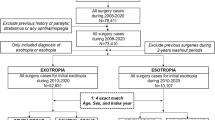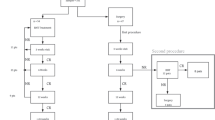Abstract
Purpose
Although less frequent than consecutive exotropia, consecutive esotropia is a well-known type of strabismus when it follows the surgical correction of an exotropia. Spontaneous conversion from initial constant, large-angle exotropia beyond the age of 3 months to esotropia or orthophoria, however, is not common. We describe a series of infants who presented a spontaneous evolution from a large-angle infantile exotropia to either an orthophoria or a spontaneously consecutive esotropia.
Methods
Cases of infants examined in the pediatric neuro-ophthalmology clinic of a tertiary ophthalmology department between 2009 and 2015, and having presented an early large-angle exotropia that spontaneously converted into an esotropia or orthophoria—i.e., without any previous surgery or botulinum toxin injection—were studied.
Results
Ten cases (6 M:4 F) were followed up. Median age at first exotropia assessment was 3.88 months (SD = 6.35). Median age at spontaneous conversion to esotropia or orthophoria was 7.23 months (SD = 14.73). Six patients suffered from severe neurologic or metabolic diseases, three had neonatal respiratory distress syndrome, and one was healthy.
Conclusion
Spontaneous conversion from initial large-angle exotropia to esotropia or orthophoria can be encountered. The cerebral maturation of visual structures probably accounts for this uncommon strabismus sequence.
Similar content being viewed by others
Log in or create a free account to read this content
Gain free access to this article, as well as selected content from this journal and more on nature.com
or
References
Hugonnier R, Hugonnier S. Physiologie des mouvements oculaires. Strabismes. Hétérophories. Paralysies oculomotrices. 4th edition, Masson, Paris, 1981.
Senior JD, Chandna A, O’Connor AR. Spontaneous exotropia in childhood. Strabismus. 2009;17:33–6.
Weir CR, Cleary M, Dutton GN. Spontaneous exotropia in children with motor fusion. Br J Ophthalmol. 2001;85:242–3.
Thorn F, Gwiazda J, Cruz AA, Bauer JA, Held R. The development of eye alignment, convergence, and sensory binocularity in young infants. Invest Ophthalmol Vis Sci. 1994;35:544–53.
Brodsky MC. Pediatric neuro-ophthalmology 307–315 (Springer, New-York, 2010).
Fitton MH, Jampolsky A. A case report of spontaneous consecutive esotropia. Am Orthopt J. 1964;14:144–6.
Buckley E, Seaber JH. Dyskinetic strabismus as a sign of cerebral pasly. Am J Ophthalmol. 1981;91:652–7.
Ghasia F, Brunstrom J, Grodon M, Tychsen L. Frequency and severity of visual sensory and motor deficits in children with cerebral palsy: gross motor function classification scale. Invest Ophthalmol Vis Sci. 2008;49:572–80.
Sondhi N, Archer SM, Helveston EM. Development of normal ocular alignment. J Pediatr Ophthalmol Strab. 1988;25:210–1.
Archer SM, Sondhi N, Helveston EM. Strabismus in infancy. Ophthalmology . 1989;96:133–7.
Nixon RB, Helveston EM, Miller K, Archer SM, Ellis FD. Incidence of strabismus in neonates. Am J Ophthalmol. 1985;100:798–801.
Horwood AM. Neonatal ocular misalignments reflect vergence development but rarely become esotropia. Br J Ophthalmol. 2003;87:1146–50.
Slater AM, Findlay JM. Binocular fixation in the newborn baby. Exp Child Psychol. 1975;20:248–73.
Riddell PM, Hainline L, Abramov I. Calibration of the Hirschberg test in human infants. Invest Ophthalmol Vis Sci. 1994;35:538–43.
Horwood AM, Riddell PM. Can misalignments in typical infants be used as a model for infantile esotropia? Invest Ophthalmol Vis Sci. 2004;45:714–20.
Acknowledgements
We thank Charlotte Creux and Marie Saudubray who performed of the orthoptic evaluations, and also Professor Pascale de Lonlay, Dr Vassili Valayannopoulos, and Professor Desguerre, who followed and treated the children with metabolic disorders.
Financial disclosure
There is no financial interest.
Author information
Authors and Affiliations
Corresponding author
Ethics declarations
Conflict of interest
The authors declare that they have no conflict of interest.
Rights and permissions
About this article
Cite this article
Voide, N., Robert, M.P. Spontaneous consecutive esotropia. Eye 32, 1197–1200 (2018). https://doi.org/10.1038/s41433-018-0060-0
Received:
Revised:
Accepted:
Published:
Issue date:
DOI: https://doi.org/10.1038/s41433-018-0060-0



